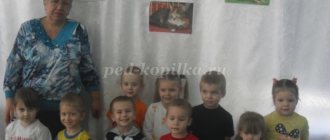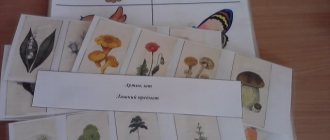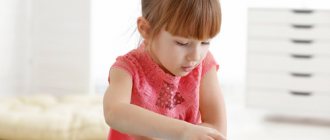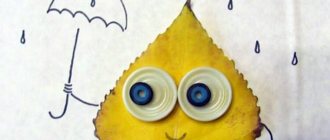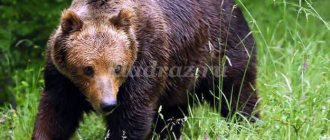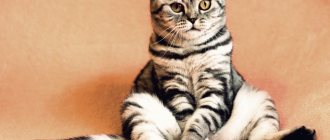Summary of educational activities for speech development in the senior group “Wild Animals of Russia”
Program objectives: 1. Continue to introduce children to the wild animals of our country 2. Clarify the body parts of animals 3. Develop the ability to form complex adjectives 4. Develop the ability to name words with the same root 5. Practice naming an animal in combination with the word “many” 6. Cultivate careful attitude towards animals
Lesson progress:
Org.
moment. On the easel there are pictures of wild animals of Russia.
Educator: Guys, look at the pictures, who do you see? Children: Fox, wolf, bear, hare, moose, hedgehog, squirrel, wild boar, badger. Educator: That's right, guys, who is this? How can they all be called in one word? Children: Animals Educator: You are right, these are animals. Tell me where do these animals live? Children: In the forest Educator: So what are they like? Children: Wild Educator: Yes, these are wild animals. They live on the territory of our country. These are wild animals of Russia. Let's imitate them a little and perform articulatory gymnastics. Articulation gymnastics 1. “Squirrel” (the mouth is closed, the thin tongue pushes first in one direction, then the other, resting on the cheeks) 2. “Bunny” (the upper lip is pulled up so that the upper teeth are visible. The lower lip is pressed to the lower teeth. Hold for 10 seconds) Educator: Guys, you and I have different moods: both good and bad. Do you think it can change in animals? Children offer answer options Educator: Let's do the exercise Exercise “Animals” Using facial expressions they depict how the wolf is angry, the hare is shaking with fear, the squirrel is worried, the fox is happy. Educator: Do you like animals? Children: Yes Educator: Call them affectionately Game “Call them affectionately” (hedgehog - hedgehog, squirrel - squirrel, hare - bunny, etc.) Educator: Well done! I want to tell you a little about the hedgehog. A hedgehog is a wild animal that lives in the forest. It has prickly needles on its back. When he is afraid, he curls up into a ball. He is a predator and eats mice. It happens that people take a hedgehog home and feed it milk. Although the hedgehog is small, it walks noisily. Let's stomp along with the hedgehog. Finger gymnastics “Hedgehog” On a dry forest path - alternately hitting fist on fist and palm on palm.
Top - top - top - stomp your feet.
They tap their fists on the table one by one.
A gray hedgehog, covered in needles, walks and wanders along the paths.
They hit fist against fist and palm against palm.
Looking for berries and mushrooms for their son and daughter.
alternately connect the fingertips of both hands with the thumb Educator: Now, stand on your feet, imagine that we are wild animals Physical exercise “Wild Animals”
On a hot day, along a forest path, the animals went to a watering hole.
(Children walk in a circle, one after another)
A moose calf stomped behind the mother elk,
(They walk, stomping loudly)
A little fox crept behind the mother fox,
(They walk stealthily)
A hedgehog rolled behind the mother hedgehog,
(They move in a deep squat)
Behind the mother bear a bear cub was walking,
(They move in a deep squat)
The squirrel cubs were galloping after the mother squirrel,
(They were jumping on their toes, with their arms bent in front of the chest)
Behind the mother-hare were slanting hares,
(They were jumping, making “ears” from their palms)
The she-wolf led the wolf cubs.
(Walk on all fours)
All mothers and children want to get drunk.
(They walk on all fours) Educator: Excellent. Do you know that two words can be made into one? Shall we try? Children: Yes Game “Name a new word” (a bear has thick paws - a bear is thick-footed, a hare has long ears - a hare is long-eared, a wolf has sharp teeth - a wolf is sharp-toothed, etc.) Educator: Look at the pictures, what parts of the body does the wolf have? animals? 1 child:
the wolf has a head, muzzle, fangs, teeth, nose, eyes, ears, paws, tail, mouth, claws, torso, neck
2 child:
the bear has a head, muzzle, teeth, nose, eyes, ears, paws , tail, mouth, claws, torso, neck
Educator: We have wild animals depicted on our easel. A lot of them. Game “One - many” (one fox - many foxes, one hare - many hares, one hedgehog - many hedgehogs.) Educator: Well done, guys. Someone is knocking on our door. The postman enters.
Hello, guys, I was told to give you a parcel from the squirrel.
Delivers the parcel. Educator: Guys, what is there? They open the package, there are nuts and a note “Bon appetit! Sincerely, squirrel"
We recommend watching:
Notes for a lesson on speech development in the senior group: Special-purpose transport Notes for educational activities on the formation of a holistic picture of the world in children in the middle group with visual impairments. Di Summary of a lesson on speech development for children in the senior group of preschool educational institutions. Summary of a lesson on speech development in the senior group. Nosov "Gardeners"
Similar articles:
Summary of a lesson on speech development in the senior group. Compiling a descriptive story based on a painting
Summary of a lesson on speech development in the senior group. Reading works of fiction
Summary of a lesson on speech development in the senior group. Retelling of a work of art. Charushin "Sparrow"
Summary of a lesson on ecology in the senior group of kindergarten on the topic “Man and Nature”
Lesson on emotional development in the senior group
Summary of a lesson on speech development in the middle group. Pets
Summary of a lesson on speech development for children 4-5 years old “Pets”
Author: Natalya Vasilievna Plotnikova, additional education teacher. Place of work: MAOU DOD “Center for Additional Education of Children”, Balakovo Description of the material: Lesson notes on the topic “Pets” are aimed at enriching the vocabulary, developing the grammatical structure of speech, and the ability to perform comparative analysis in children 4-5 years old. The methodological development of the lesson is available in practical application and can be used in classes by teachers of preschool educational institutions and teachers of additional education for children. Goal: Activation of the dictionary, development of the ability to perform comparative analysis. Objectives: educational: consolidation and expansion of ideas about domestic animals, development of the ability to perform comparative analysis. developing: development of the grammatical structure of speech, development of memory, attention, imagination, thinking. educational: to cultivate love and respect for animals, the ability to listen to comrades. Types of activities: gaming, motor, cognitive, communicative. Progress of the lesson: Conversation on the topic: - What domestic animals do you know? -Why are they called that? (Children name the animals, the teacher displays their images on the board). -What benefits do they bring to people? — How does a person take care of animals? —What do domestic animals eat? —What is the body of a sheep, horse, or pig covered with? "Comparison of body parts of a cow and a horse." —What does a cow have that a horse doesn’t? (Horns) - What does a horse have that a cow doesn’t? (Mane) - Compare the legs and tails of these animals. What is the difference? — Why do a horse have longer legs than a cow? - What does a cow have an udder for? Game exercise “Name it affectionately.” Every child has a toy pet. Children take turns calling each of their animals affectionately. Physical education minute “Hamka” Hamster, hamster, hamster Striped barrel. The hamster gets up early, washes his cheeks, rubs his neck. Khomka sweeps the hut and goes out to exercise. One two three four five! Khomka wants to become strong. Game exercise “Who has who?” The teacher shows an image of an adult animal and a baby: “Who is the cow?...Who is the sheep?” (children call cubs). “Say the word” (from S. Pogorelovsky) The crows are with the crows, The elephants are with... (baby elephants). And our pasta has... (macarons). And bigger, and... (smaller), And thicker, and... (thinner) - And the Macoron boys, And the girls -... (Makoron). Game exercise “One-many”. Children stand in a semicircle in front of the teacher. The teacher has a ball. - I name you an animal, and you throw me a ball and name it if there were a lot of them. For example, “cow” and if there are a lot of “cows”. Game “Cut Pictures” (Children lay out pets from cut pictures). Finger game “Goat” An old man was walking along the road and found a hornless goat. Come on, goat, let's jump, kick our legs. And the goat butts, and the old man swears. (Walk with your fingers on the table, show the horns with your fingers, tap your fingers on the table, show the horns again, wag your fingers) Guessing riddles A furry man walks, a bearded man walks, he waves his horns, shakes his beard, taps his hooves. (Goat) Who is not in the heat, nor in the cold doesn't take off his fur coat? (Sheep) Gray, but not a wolf, Long-eared, but not a hare, With hooves, but not a horse. (Donkey) He is friends with the owner, guards the house, lives under the porch, and has a tail like a ring. (Dog) Long ear, ball of fluff. Jumps deftly, gnaws carrots. (Rabbit) Who has a snout that is not clenched in a fist? His feet have hooves. He eats and drinks from a trough. (Piglet) Game "Fourth wheel". Children are shown a picture depicting 1. dog, goat, chicken, horse. 2. goat, cow, horse, ram. 3. camel, cow, cat and horse. 4. pig, sheep, camel, rabbit. Well done boys! What animals were we talking about? Why are they called that? What games did you like?
We recommend watching:
Summary of a mathematics lesson in the middle group “Journey to a fairy forest” Summary of a winter walk in the senior group Summary of GCD in the senior group on the topic Mushrooms Summary of GCD in the preparatory speech therapy group. My city
Similar articles:
Lesson summary on artistic and productive activities in the middle group
Summary of GCD in the middle group on the topic: My home
Summary of a lesson on ecology in the middle group
Summary of a lesson on environmental education in the middle group
Summary of joint activities of children and parents in the secondary group “My Russia”
